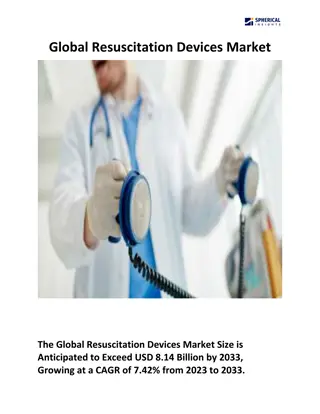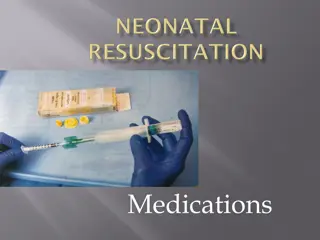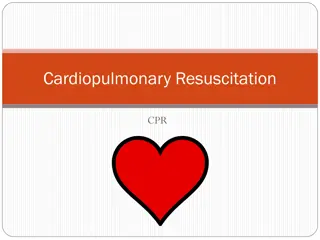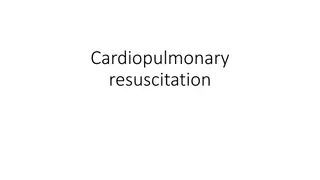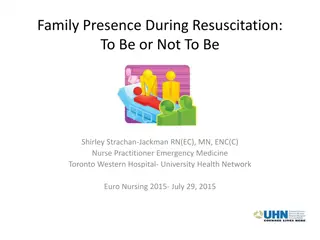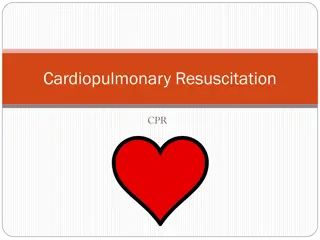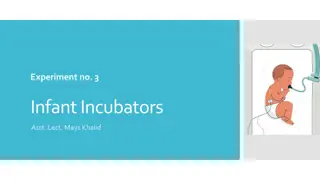Understanding and Supporting Premature Babies: Resuscitation and Care
Premature babies are at higher risk of complications due to their physiological vulnerabilities. They require specialized care to maintain body temperature, assist ventilation, manage oxygen levels, and minimize the chances of lung and brain injuries. Learn why preemies face increased risks and discover essential strategies for their well-being during the critical stabilization period.
Download Presentation

Please find below an Image/Link to download the presentation.
The content on the website is provided AS IS for your information and personal use only. It may not be sold, licensed, or shared on other websites without obtaining consent from the author. Download presentation by click this link. If you encounter any issues during the download, it is possible that the publisher has removed the file from their server.
E N D
Presentation Transcript
Objectives Why premies are at higher risk of medical complications Additional resourced needed Strategies to maintain body temperature How to assist ventilation O2 management Ways to decrease chances of lung and brain injury Considerations after initial stabilization period
Why do premies have higher risk of complications? Skin: thin, less fat, large surface area, limited metabolic response to cold RAPID HEAT LOSS Weak chest muscles, flexible ribs DECREASED EFFICIENTY BREATHING EFFORTS Immature lungs, lack surfactant DIFFICULT TO VENTILATE INJURY FROM PPV Immature tissues DAMAGED BY O2
Premies cont Infection of amniotic fluid plus baby s immature immune system SEVERE INFECTIONS Smaller blood volume to loose RISK HYPOVOLEMIA Immature blood vessels in brain cannot adjust to rapid changes in blood flow RISK of INTRACRANIAL BLEEDING OR HYPOXIA Limited metabolic reserve and immature compensatory mechanisms RISK HYPOGLYCEMIA
Additional resuscitation resources Temperature control Servo- controlled radian warmer with a temperature sensor Polyethylene bag/wrap Ventilation O2 blender, oximeter, small sensors T-piece or flow inflating bag for PEEP/CPAP Preterm sized resuscitation mask, size-O laryngoscope blade, ET tubes 2.5, 3.0 mm Surfactant? Cardiac monitoring ECG monitor
How to keep baby warm Increase temperature in room: 23-25 C and preheat warmer Transport incubator with blended O2 Babies < 32 wks gestation Hat Thermal mattress under the blanket on radian warmer Wrap baby in polyethylene plastic bag/wrap-keep baby covered Monitor baby s temperature, avoid over heating Maintain axillary temperature 36.5-37.5C
Assisting Ventilation If apnea, gasping or HR <100 bpm after 60 sec birth, despite initial steps, start PPV If breathing spontaneously and HR >100 bpm, PPV not required If labored respirations or O2 saturation below the target range, CPAP helpful
Special Considerations for Premies If baby breathing spontaneously, labored, and HR > 100 bpm, use early CPAP instead of intubation CPAP alone is NOT appropriate if baby not breathing, HR , 100 bpm If PPV is required, use lowest inflation pressure (20-25 cm H2O) necessary to achieve and maintain a HR >100 bpm Airway obstruction and mask leak common: change head/neck position Use CO2 detector device If PPV is required, preferable to use a device that can provide PEEP (5 cm H2O) with T-piece, flow inflating bag, ET tube Surfactant if baby required intubation for respiratory distress
How much O2? Initiate resuscitation in babies < 35 wks gestation with 21% to 30% O2 Use pulse oximeter and O2 blender to maintain O2 saturations in same target range for full term term babies
How to decrease change of neurological damage Handle baby gently Do not position baby s legs higher than the head Avoid delivering excessive pressure during PPV or CPAP Can cause pneumothorax, interfere with venous return from the head, both these can lead to brain hemorrhage Use pulse oximeter and blood gases to monitor and adjust ventilation and O2 concentration Do not rapidly infuse IV fluids
Precautions after initial stabilization Monitor baby s temperature Monitor blood glucose Premies have lower amounts stored glucose Secure IV access, initiate dextrose infusion Monitor for apnea and bradycardia May be first clinical sign of abnormality in body temperature, O2, CO2, electrolytes, blood glucose, blood acid levels




